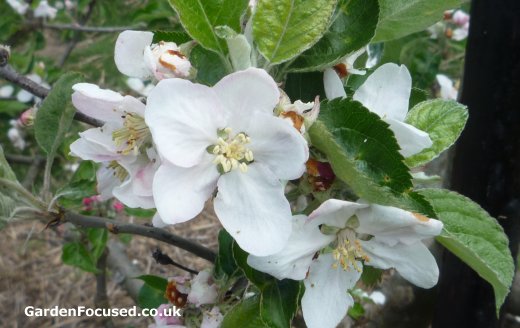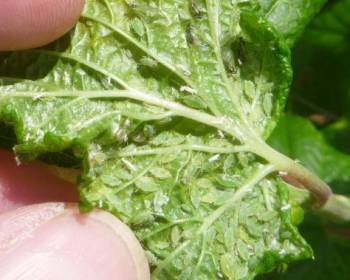CLAYGATE PEARMAIN APPLE TREE
Article by David Marks
The Claygate Pearmain apple tree was first identified as a new variety by John Braddick who lived in Claygate, Surrey, hence the name of this variety. It has received a variety of awards after its discovery in 1821 including an Award of Merit in 1901, a First Class Certificate in 1921 and an AGM in 1993. Braddick also discovered the rather rarer Braddick’s Nonpareil.
This is an eating apple and was planted in many orchards and country houses during the Victorian era and the Edwardians were also rather fond of it. Not one of the common apple trees grown today but many still exist in old orchards.
PARENTAGE
The parents of Claygate Pearmain are not known. It has however recently been categorised as a triploid variety.
APPEARANCE, TASTE AND CHARACTERISTICS OF CLAYGATE PEARMAIN
Claygate Pearmain is a russet apple with various amounts of the skin being affected. Normally about a third is affected but often only the very top of the apple shows russeting. The basic colour is green which is overlaid with reds and oranges, more so on the sunny side of the apple.
The flavour is slightly nutty with a refreshing balanced apple and often pineapple flavour. This is not a weak flavoured variety, it’s is most definitely full and rich. The texture is soft and there’s lots of juice.

Claygate Pearmain is a triploid apple variety so it will need another apple tree nearby to pollinate it successfully. For a list of suitable varieties see our pollination partner list below. One of the common advantages of triploid apple varieties is that they are resistant to some of the more common diseases and Claygate Pearmain is no exception. It is very resistant to scab amongst other diseases and it thrives north of Watford even tolerating some water logging in winter. It is a regular cropper rarely missing a year.
The tree itself is uncharacteristic for a triploid, it is a compact tree with branches that tend to grow upwards rather than spread if left to its own devices. Although not a mainstream variety we thoroughly recommend this apple tree especially if you live in cooler and / or wetter areas of the UK (Midlands upwards).
Picture from public sector information licensed under the Open Government Licence v2.0.
CLAYGATE PEARMAIN PESTS AND DISEASES
Claygate Pearmain is an old triploid variety and has reasonably good pest and disease resistance. One outstanding feature is its resistance to scab, a disease which affects many other varieties. It also has some resistance to canker which makes it an ideal choice for wetter and colder parts of the UK.
If a pest is likely to trouble your Claygate Pearmain it will probably be aphids. The first signs to look out for are the pests themselves on the undersides of the leaves. Often they are not initially visible with the naked eye so a magnifying glass may be required.
Secondary signs of aphids are leaves curling inwards and distorted. The attack won’t be fatal to the tree but if the infestation is significant it will affect the number of apples which reach full size. Read our article dedicated to recognising, avoiding and treating aphids here.
For a full description of common apple pests and diseases click here.
BUYING A CLAYGATE PEARMAIN APPLE TREEE IN THE UK
This is not an apple tree which you will find in any of the discount stores, indeed it is not = often sold in many garden centres. It is however sold frequently online at a good number of established nurseries and is easily found online.
SUMMARY CHARACTERISTICS OF CLAYGATE PEARMAIN
USE: Eating
SKIN COLOUR / TEXTURE:: Mainly green, overlaid with yellow, orange and red, some russet
FLESH COLOUR: Creamy white
TASTE AND TEXTURE: Nutty, pineapple, full tasting and juicy
FRUIT SIZE: Average
STORAGE QUALITIES: Keeps for a month, more if stored in ideal conditions.
SUITABILITY FOR CORDON / ESPALIER GROWTH: Yes
TREE SIZE: Average size depending on rootstock and conditions
REGULARITY OF
CROPPING: Very regular
POLLINATION: Group 4, self-sterile (triploid) and needs a suitable pollination partner
AWARDS: RHS AGM in 1993
SPECIAL FEATURES:: Good taste, excellent disease resistance, late cropper
FLOWERING AND HARVEST TIMES:
The average flowering time (optimum time for pollination) and date when fruits are ripe for harvest in the UK for the Claygate Pearmain apple tree are set out below. If you have set your home town we can give you a more accurate estimate, if you have not set your home town (do it now by clicking here) the dates below will be the average for the UK. Your town has not been set, the average main flowering time for Claygate Pearmain in the UK is the third week of May. Fruit will be ready for harvesting in the first week of November. Click here if you want to set the dates to your home town.
Note that the fruit picking dates for Claygate Pearmain are rather more variable compared to many other varieties, the above dates are, therefore, unusually variable.
Flowering and fruit picking dates vary according to the weather in any particular growing season so the above dates may well change slightly from one year to the next. The flowering date above is when the apple tree produces the maximum number of blossoms, it will also produce blossom, although less, a week or two either side of the date given.

![]()
Blossom of Claygate Pearmain
CLAYGATE PEARMAIN POLLINATION PARTNERS
We list below varieties which are suitable pollination partners for Claygate Pearmain which is in pollination group 4 and self-sterile (also a triploid).
- Arthur Turner – pollination group 3, self-sterile, cooker
- Bountiful – pollination group 3, self-sterile, cooker
- Braeburn – pollination group 4, self-fertile, eater
- Charles Ross – pollination group 3, partially self-fertile, cooker and eater
- Court of Wick – pollination group 3, self-sterile, eater and cooker
- Discovery – pollination group 3, self-sterile, eating and cider
- Dumelow’s Seedling – pollination group 4, self-sterile, cooker
- Ellison’s Orange – pollination group 4, partially self-fertile, eater
- Emneth Early – pollination group 3, partially self-fertile, cooker
- Epicure – pollination group 3, self-fertile, eater
- Falstaff – pollination group 3, self-fertile, eater
- Fiesta – pollination group 3, partially self-fertile, eater
- Gala – pollination group 4, partially self-fertile, eater
- Golden Delicious – pollination group 4, partially self-fertile, eater and cooker
- Granny Smith – pollination group 3, self-fertile, eater and cooker
- Grenadier – pollination group 3, partially self-fertile, cooker
- Honeycrisp – pollination group 4, self-sterile, eater
- Howgate Wonder – pollination group 3, partially self-fertile, cooker and eater
- James Grieve – pollination group 3, partially self-fertile, cooker and eater
- Katy – pollination group 3, self-sterile, both
- Kidds Orange Red – pollination group 3, self-sterile, eater
- King of The Pippins – pollination group 4, partially self-fertile, eater and cooker
- Lanes Prince Albert – pollination group 4, self-sterile, cooking
- Laxtons Fortune – pollination group 3, partially self-fertile, eater
- Laxtons Superb – pollination group 4, partially self-fertile, eater
- Lord Derby – pollination group 4, self-sterile, cooker
- Merton Beauty – pollination group 5, self-sterile, eater
- Newton Wonder – pollination group 4, partially self-fertile, cooker
- Peasgoods Nonsuch – pollination group 3, partially self-fertile, cooker
- Rajka – pollination group 4, self-sterile, eater
- Red Falstaff – pollination group 3, partially self-fertile, eater
- Scrumptious – pollination group 3, self-fertile, eater
- Sops in Wine – pollination group 3, self-sterile, juicer
- Spartan – pollination group 3, self-fertile, eater
- Sunset – pollination group 3, self-fertile, eater
- Tydemans Late Orange – pollination group 4, self-sterile, eater
- Waltz – pollination group 3, self-sterile, eater
- Winston – pollination group 4, self-fertile, eater
- Worcester Pearmain – pollination group 3, partially self-fertile, eater
The full list of apple tree varieties which we have reviewed is listed below. Select any one of them and then click the “More Information” button to be taken to the in depth review:

COMMENTS / QUESTIONS LEFT BY OUR READERS
Awaiting your comments
n/a
WHY NOT LEAVE YOUR QUESTION / COMMENTS ABOUT THIS PAGE?
ENTER THEM BELOW. EMAIL ADDRESS IS OPTIONAL.
YOUR COMMENTS WILL BE ADDED ABOVE WITHIN A FEW HOURS.
[contact-form-7 id=”1882″ title=”Contact form 1″]